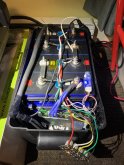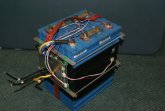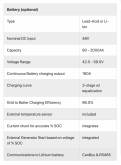Hello everyone,
Sorry for the very long post, but after reading this entire thread, I thought I'd explain my thoughts on what is being discussed and how I plan to use this BMS in my project.
I have received 3 of these 100 Amp Smart BMS devices for my project. I ordered mine through ebay, from China and they took a few weeks to show up. Ordered them right after watching Will's first video on the $555 battery build. I needed that cold temp shutoff and loved the bluetooth programming option.
I've read this entire thread after building my first complete battery and spending some time with the app on my Samsung S7 phone. Just knew that a thread like this had to exist on this forum. I have a few things to add to the conversation. I also need to learn more about the app and the options we can control throught its interface. So far, I don't see a summary of all of the parameters that we can adjust; has anyone compiled one or found documentation for this BMS we can refer to (in english)?
I am using CALB lithium iron phoshate 130 Ah cells purchased 8 years ago for an EV project that I completed, ran for 16K miles and then took off the road, due to insurance costs, and OEM EV advancement. I am recycling a lot of equipment from my EV project to build an AC/DC system for my camper.
1. Why can't batteries like this be connected in series? Maybe I missed something... I assume that I can't connect these 3 batteries in series because that means all of the system's current would have to pass through each BMS. In my EV I had effectively, one big 144 VDC battery that routinely put out 300 amps for short periods of time. There was no BMS directly in the circuit like we see with this BMS. We all know the size of the wires that come with this BMS have limited current carrying capacity. Is my assumption correct?
2. I saw the mention of using seperate charge control and seperate discharge control. I don't think I can do that. I am treating the three batteries that I am building as distinct batteries with there own internal controls. As if I had purchased 3 Battleborn batteries.
My intent is to connect them in parrallel for a max output from each of approximately 61 amps. Which, I probably need to bump up a bit which means adding a third 10 gauge wire to each side of each BMS to account for the worst-case senerio which is driving a 2000 watt Xantrex inverter and all of the normal DC loads (water pump, tv, lights, furnace) in my camper. I expect to be at max output only when the microwave, or something else is running in the camper. The primary need for AC while boondocking is for my wife's sewing machine which has very low power requirements compared to that microwave. Certainly appropriate load management will play into the picture.
3. How do I get around having two devices trying to do the same thing? Well, at the moment, I plan to configure the BMS to disconnect from charging at something like 15 volts but configure my Victron MPPT 150v/50 amp charge controller to consider 14.6 as the max battery voltage. The charge controller will also monitor battery temp with the Victron temp sensor bluetooth device. I consider the BMS Low Temp feature as a good redundancy feature. I also plan to use the BMS as my low voltage cutoff device, set to something like 12 volts. I had originally included a Victron 220 battery protect in the system but after reading another thread about applying reverse current to that device, I believe I've already toasted it, so it has to come out of the circuit. (how annoying!)
4. For state of charge monitoring, I will of course use the app on my phone with a hardware backup. I have an amp hour counter and display from my EV project that I used very successfully as my 'fuel gauge' to make sure I was VERY gentle with the batteries (thinking SOC). Positioning the shunt for my amp hour counter means that all charge and discharge current must pass through it's shunt. That device can display the battery pack voltage, current loads, and accumulated and consumed amp hours.
5. Battery temp control. Seems that cutting off charge at low temps is covered. However, in the winter I may want to charge as well. In my EV, each battery box had a custom AC heating mat using material that I found on a web site specializing in keeping pets warm. Pets like lizards and turtles so it couldn't get above 65 degrees F. I programmed an Arduino to monitor the temps and warm the batteries when the EV was parked in my garage, connected to 110 VAC solely for the purpose of keeping the cells warm enough. Now, with the option for a 12VDC heating mat, I will likely go that way if needed. I am building a custom weather tight aluminum battery box for the front of my camping trailer to house all of this equipment and can insulate that box a bit, if I need to. However, I'm more concerned about ventilation because my plan is to start snow-birding from Northern Idaho to Arizona. But even in Arizona, I understand we might see temps at or near freezing routinely, at the start or end of the season. I really don't expect to see uppper temps in the battery box that might cause a problem. However, I will monitor that and adjust as needed... something like this is never finished... where is the fun in that?
I still have a number of issues with this project to address. Such as handling AC charging. Hoping that might be as simple as switching to a converter intended for this batter chemistry.
If you have made it this far, please let me know if you see any fatal flaws in my design or have any comments to share.












